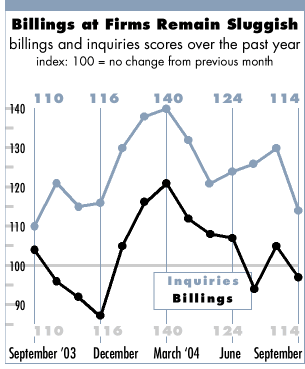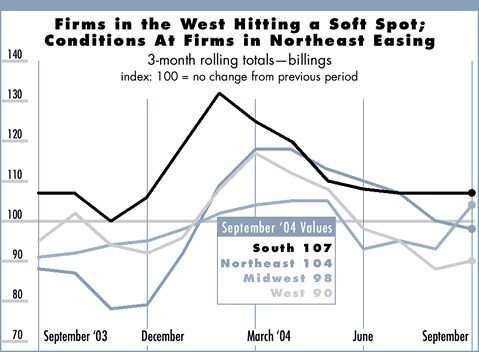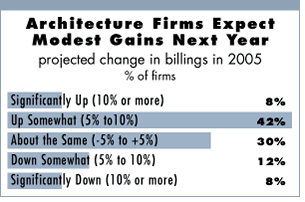

Another Bump in the
Road in September
Recent weakness in billings matched by
reticent outlook for 2005

by Kermit Baker,
PhD, Hon. AIA
Chief Economist
 Billings at U.S. architecture firms dipped in September
for the second time in the past three months. Larger firms in particular
reported weak conditions in September, as only 8 percent of firms with
annual billings of $5 million or more reported increases, while 24 percent
of these firms reported declines.
Billings at U.S. architecture firms dipped in September
for the second time in the past three months. Larger firms in particular
reported weak conditions in September, as only 8 percent of firms with
annual billings of $5 million or more reported increases, while 24 percent
of these firms reported declines.
Firms concentrating in the residential sector reported strong increases in billings, while firms concentrating in the nonresidential sectors (commercial/industrial, institutional, or mixed) all reported declines on average. Inquiries for new work increased, but not as much as in previous months. The strongest gains in inquiries were at commercial/industrial firms. Still, trends in project inquiries point to future improvements in billings.

Regionally, firms in the Midwest and South showed gains, with a slight decline at firms in the Northeast, and a significant drop at firms in the West. Regional patterns have been unusually volatile recently, with firms in all regions except the South reporting some dips in billings over the past several months.
Disappointing third quarter
Federal Reserve Board Chairman Greenspan recently proclaimed that oil
prices at current rates were unlikely to have a serious negative long-term
impact on the economy. However, their immediate effect is clearly being
felt. Employment gains have been disappointing in recent months. Construction
employment also has slowed; payrolls at construction firms increased
by an average of more than 20,000 a month during the first half of
the year, but dropped to under 10,000 a month during the third quarter.
Business executives felt less optimistic in the third quarter, according to the Conference Board’s Survey of Business Confidence. Consumer sentiment continued its downward movement in October according to preliminary results from the University of Michigan. Housing starts, in spite of a dip in September, were still running at a 1.9 million annualized rate. Multifamily starts even picked up their pace a bit in September.
Higher oil prices are showing up in the inflation figures. Producer prices increased 3.6 percent in the third quarter compared to a year ago. Without the more volatile fuel and food components, producer prices are increasing at a 1.7 percent rate. Consumer prices grew by 2.7 percent over the same period, and also have been trending up over the past few years. Without the fuel and food elements, consumer prices are increasing at a 1.8 percent pace over the past year.
 Modest hopes for 2005
Modest hopes for 2005
Despite solid improvements in business conditions earlier this year,
many firms have modest expectations about the outlook for 2005. Half
of firms expect some increases next year, whereas 20 percent are expecting
declines. Of the firms that expect improvement, most project that increases
in billings will be under 10 percent. As many firms anticipate a significant
drop in business in 2005 as expect a significant rise.
Across all firms, increases in business activity are projected to be in the 2.0–2.5 percent range. Once inflation adjustments are factored into costs (increases in staff compensation, operating costs, supplies), this produces very little growth in net revenue at most firms. Commercial/industrial firms expect gains of close to 4 percent next year, while institutional firms expect hardly any gains in billings (less than 1 percent) on average.
Copyright 2004 The American Institute of Architects.
All rights reserved. Home Page ![]()
![]()
 |
||
| This month, Work-on-the-Boards survey participants are saying: • Private sector work continues to increase. After an office
market down-cycle of the last couple of years, a few developers
are ready to do speculative work again. • Everyone is looking very aggressively for new work. Also
everyone believes post-election times will yield more work. • Our city has had three major factories close, so the economy
is “iffy.” • The increase in activity is welcome. The decrease in project
size is not.
|
||